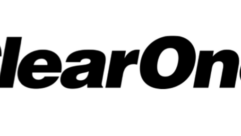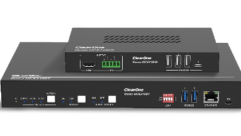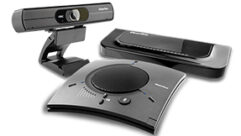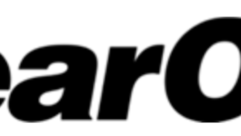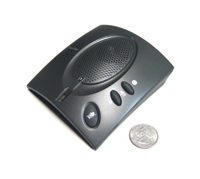

ClearOne Chat 60
Jul 29, 2010 12:00 PM,
By John McJunkin
A simple device for telecommuting.
Analog telephony has been the principal means of voice communication for business seemingly since the beginning of time. Indeed, analog telephony has existed for well in excess of a century, and it has served commerce well, but it was bound to be supplanted eventually. In the same way the manual typewriter was eventually replaced by the word processor, landline telephony has been doomed to inevitable demise. Cellular phone technology, email, and more recently, SMS and MMS text messaging have pushed traditional telephony further into the background.
Nevertheless, the business world recognizes the value of communication via the human voice, and voice communications are not likely to go away anytime soon. Still, voice communication technology must necessarily advance. Voice over internet protocol (VoIP) has emerged as an efficient way to accomplish voice communication, and it has been leveraged by many organizations to meet communications needs. It can provide a much richer experience than traditional telephony by virtue of its superior audio quality. In recent years, a number of manufacturers have developed sophisticated black-box technology to make VoIP available, and as competition mounts, the quality has increased and the pricing has decreased. ClearOne of Salt Lake City, Utah, has capitalized on infrastructure developed by Skype to further simplify the process and make it less expensive to implement. The resultant technology is the Chat 60, a personal speakerphone intended for applications ranging from small office/home office (SOHO) to teleconferencing for traveling professionals or telecommuters.
There are numerous acoustical interface solutions available for the use of VoIP, the most common of which is probably the headset with a boom microphone. These are certainly useful, but they pose two primary drawbacks: the user’s range of motion is limited by the connecting cable, and there is some inherent discomfort and fatigue associated with wearing a headset. ClearOne sought to eliminate these disadvantages with the development of the Chat 60, which is a Skype-enabled speakerphone. Skype is a popular global VoIP network that simplifies the process and facilitates not only VoIP, but video telephony as well. While the Chat 60 does not incorporate a camera for video telephony, Skype users frequently use laptop computers that incorporate a camera, and these can be used in conjunction with the Chat 60 to accomplish a videoconference. There are other products in ClearOne’s Chat line, some more sophisticated, and others less so, but the Chat 60 is the one Skype-certified product in the line intended specifically for personal use.
When I unboxed the Chat 60, since I already had Skype installed and configured on my computer, I was able to plug the unit in and proceed. The process truly could not have been any simpler. I wanted to observe the process when a user did not have Skype installed (and also when the user is not an audio professional), so I handed the Chat 60 to an acquaintance in its box and asked her to proceed according to the included quick-start guide. She downloaded and installed Skype, established a Skype account, and was communicating with me (via video telephony, no less) in about 10 minutes. In the case of a device specifically intended for personal use like the Chat 60, it is important to establish that a nonprofessional can quickly and easily get the system connected, configured, and operational—and that is certainly the case here.
In spite of its procedural simplicity, the Chat 60 is a powerful communications device. It employs HDConference audio processing technology to provide sound that is substantially higher in quality than that available via traditional telephony. In further detail, the Chat 60 operates in full-duplex mode, providing simultaneous audio in both directions. The unit features echo cancellation to reduce the aural mushiness that can result from a large room with reflective surfaces. It also employs noise cancellation to further improve the clarity and sharpness of the user’s speech, and it features advanced automatic level management to provide a consistent signal to the other party on the line. I discovered the audio quality to be surprisingly superior to traditional telephony, and considering the technical specifications, that’s no surprise. The unit’s loudspeaker reproduces 220Hz to 14kHz, and its microphone captures 20Hz to 10kHz.
ClearOne Chat 60
Jul 29, 2010 12:00 PM,
By John McJunkin
A simple device for telecommuting.
The 1/2lb. tabletop unit is 3.8″x4.1″x1.8″—small and unobtrusive. The loudspeaker is protected by a plastic oval grille, and at the end of the oval closest to the user, the unit’s microphone is recessed into the plastic. An LED just above the microphone indicates system status. The Chat 60 sports just three buttons on its top panel—volume up, volume down, and mute—and they’re very clearly labeled and nicely placed (with the slightly larger and more frequently used mute button closer to the user in the front of the device). The rear panel of the Chat 60 is also simple. There is a DC power inlet for use of an optional external power supply, a USB jack that is usually used for power when plugged into a computer, and a 2.5mm jack for connection to other devices, such as traditional or cellular phones. The system is not limited to use with Skype, but that is its principal intended application.
Related Links

Technology Showcase: Conference-room Telephone Systems
Even with the wide variety of conference-microphone systems and videoconferencing equipment, the most familiar piece of hardware to be seen in conference…

Expert Roundtable: AV Meets IT
Like the raging streams of the mighty Nile River, the two currents of audiovisual (AV) communication and information technology (IT) are combining to…

ClearOne of Salt Lake City is well known for high-quality conferencing systems. The company’s latest offering is yet another example of why it is on the…
Advanced control of the Chat 60 is available via computer when the unit is connected via USB. The unit can be optimized for use with specific telephone models, in addition to computers and videoconferencing devices. The software also facilitates firmware updating of the Chat 60, and advanced control of levels and signal routing, for instance when using external loudspeakers. Line echo cancellation is also available with this software exclusively for use with a regular telephone line. One minor disappointment here: The software is only available for Windows. While it’s true that a substantial share of the laptop market is dominated by the Windows operating system, there are still millions of Apple users, even in the business domain. Hopefully ClearOne will eventually port the software to the Mac OS.
I discovered the ClearOne Chat 60 to be inexpensive, easy to use (even for nonprofessionals), and very useful for business. Traveling sales professionals and telecommuters in particular will find the device vastly improves the quality of the communication experience. And if more sophisticated solutions are necessary, I can recommend taking a look at the remainder of ClearOne’s line. The Chat 60 is worth checking out.
John McJunkin is the principal of Avalon Podcasting in Chandler, Ariz. He has consulted in the development of studios and installations, and he provides high-quality podcast-production services.
Product Summary
- Company: ClearOne
www.clearone.com - Product: Chat 60
- Pros: Easy to use, good quality, inexpensive.
- Cons: No support for Apple operating systems.
- Applications: Travel teleconferencing, Skype calling, telecommuting.
- Price: $149
Specifications
- System requirements: Microsoft Windows XP or Vista
- Skype: 1GHz CPU, 256MB RAM
- Speaker bandwidth: 220Hz-14kHz
- Max output level: 80dB SPL @ 1ft.
- Microphone bandwidth: 20Hz-10kHz
- Line input frequency response: 20Hz-20kHz ¡¾1dB
- Maximum input level: 0dBu
- Input impedance: 10K§Ù
- Line output frequency response: 20Hz-20kHz +/- 1dB
- Maximum output level: 0dBu
- Output impedance: 50§Ù


